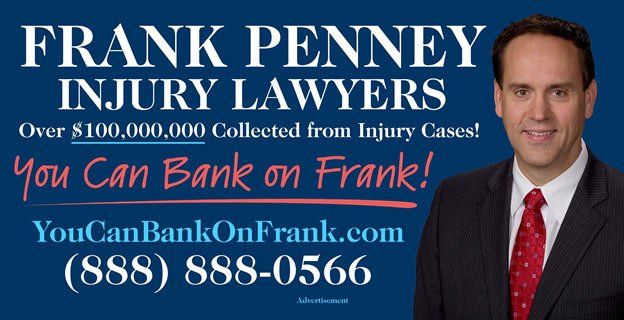GET YOUR FREE CONSULTATION
Short FAQ About Hiring a Personal Injury Attorney
Read the blog from Frank Penney Injury Lawyers in Roseville, CA below.
Getting in a personal injury accident, whether it is a slip-and-fall, car accident, or medical malpractice, is a stressful time in a person’s life. It can be quite scary dealing with the unknown, such as mounting medical bills and how they will get paid, how and when to replace a vehicle, insurance claims, and whether to talk to an insurance adjuster. It is especially difficult if your injury impacts your daily life and delays your ability to get back to normal.
An experienced personal injury lawyer can help you navigate what can often be a very complicated process. There are also personal injury resources you can utilize for more information.
What can an attorney do for me?
- They know what to say (and more importantly, what not to say) when dealing with insurance adjusters.
- They know how to draft demand letters, request the highest possible dollar amount, and negotiate the best settlements for clients. Based upon the facts, they know what these cases are generally worth.
- They know how to objectively look at the facts of your case at a time when you might be very emotional or dealing with the results of your injury.
- They know how to get a copy of the police report if one was created.
- They know how to get your medical records.
- They know how to negotiate your medical bills after the case settles.
- They often have teams of experts that they work with, such as accident reconstruction experts, medical professionals, and investigators. They may even have previous experience with the adjuster or the insurance agency.
- They understand the laws related to your particular injury. As discussed in other articles, there are statutes of limitation and timelines that must be strictly followed once a case gets to a certain point.
- If you must file a lawsuit, an attorney knows how to articulate the Complaint of Damages and the affiliated causes of action.
- They know how to have valuable conversations with the defendant’s attorney.
How much does it cost?
Personal injury attorneys often offer a free consultation to their clients to assess the merits of a potential personal injury case. Once they decide to take on a matter, they typically get paid on a contingency fee basis. What that means is that they do not get paid unless the case settles and once settled, the attorney takes a fee that is a percentage of the recovery. That fee is usually 33.3% if the case has not been filed with the superior court, and 40% if it has.
Example
| Settlement | $100,000 |
|---|---|
| Attorney Fee of 33% | -$33,000 |
| Client’s Share | $67,000 |
Does the attorney work with my medical providers?
One of the benefits of having an attorney is that they often have professional relationships with medical providers. However, some underinsured victims are unable to get the care they need. In that regard, having an attorney who has relationships with medical providers such as chiropractors or physical therapists is key because these providers will often render care without charging upfront. This is called care on a lien-fee basis. What this means is that the medical provider renders the services with a lien signed by the attorney where the attorney guarantees payment for the care from the client’s personal injury settlement.
Once the case settles, the attorney is obligated by the terms of the lien to pay the providers before paying the client.
Example
| Settlement | $100,000 |
|---|---|
| Attorney Fee of 33% | -$33,000 |
| Remainder | $67,000 |
| Doctor A | -$11,000 |
| Doctor B | -$10,000 |
| Client’s Share | $46,000 |
Does the attorney advance any costs?
At times, an attorney will realize that financing a case is difficult for clients and they will decide to advance costs. Examples are things like: filing fees, police report fees, accident reconstruction, medical records fees, etc. When the attorney does this, he/she is reimbursed for those costs at the time of settlement. What is nice for the client is that they do not have to worry that they are unable to afford the costs of a lawsuit.
Example
| Settlement | $100,000 |
|---|---|
| Attorney Fee of 33% | -$33,000 |
| Remainder | $67,000 |
| Doctor A | -$11,000 |
| Doctor B | -$10,000 |
| Police Report | -$15.00 |
| Medical Records | -$150.00 |
| Filing Fee | -$435.00 |
| Accident Reconstruction | -$1,500 |
| Client’s Share | $46,000 |
Are there any drawbacks to hiring an attorney?
Some argue that, if you did not use an attorney, you would not have to share a fraction of the settlement with someone else. But the reality is that you’d be unlikely to get such a high personal injury case settlement without the use of an attorney. There are really no negatives to learning how to hire a personal injury lawyer because they are poised to get the highest dollar amount possible since their fee is contingent upon settlement.
If you have been in a personal injury accident, it is important to get the medical care you need promptly and without delay. It may also be important to find a reputable personal injury attorney to help navigate the process.
No Fee Guarantee!
Our legal team understands that life can be very stressful after an accident of any type. The financial costs of your accident can add to that stress. When you are asking for help, this should make your life easier – not more difficult. That is why you do not have to worry about any upfront legal fees and expenses when you hire Frank Penney Injury Lawyers to handle your California personal injury case.
At Frank Penney Injury Lawyers, Frank Penney and his staff work on a contingency basis. This means you only have to pay a fee if you win your case. We will never charge a fee unless we obtain a settlement on your behalf. No win. No fee. Case closed.
This means there is no risk in asking Frank Penney Injury Lawyers for help. You get to benefit from Frank Penney’s years of experience, knowledge, and success without needing to stress about the cost. Call today to set up a free initial case assessment or to learn more.
When I first contacted the Law Offices of Frank D. Penney after my accident, I was frustrated with car insurance companies, and medical insurance companies; after all, I was in pain. He and his staff put me at ease instantly! It was such a relief to have someone working on MY BEHALF! They were able to settle my case for more than I initially thought it was worth. THANKS AGAIN!!!
- KRISTA H.
Read more
client testimonials.
Why Choose Us?
- If You Don’t Win, You Don’t Pay
- Free Case Evaluations
- Over 25 Years of Experience
- Compassionate and Caring
- Highly Rated Reviews
- Proven Track Record
- 24/7 Availability
- Quick Response Time
- And More
Our Recent Blog Posts



24/7 Availability – Reach Us by Phone, Email, Chat and More!
If you are involved in any type of personal injury due to the fault of someone else, our experienced team at Frank Penney Injury Lawyers in Roseville, CA can help. We are available to anyone in Northern California 24/7! Give us a call today to learn more at 888-888-0566. We will fight for your rights!
Contact Our Team Today
Frank Penney Injury Lawyers can be reached at the following locations:
No matter where you are in Northern California, or how you reach us, we will be there for you 24/7!
You Can Bank on Frank!





